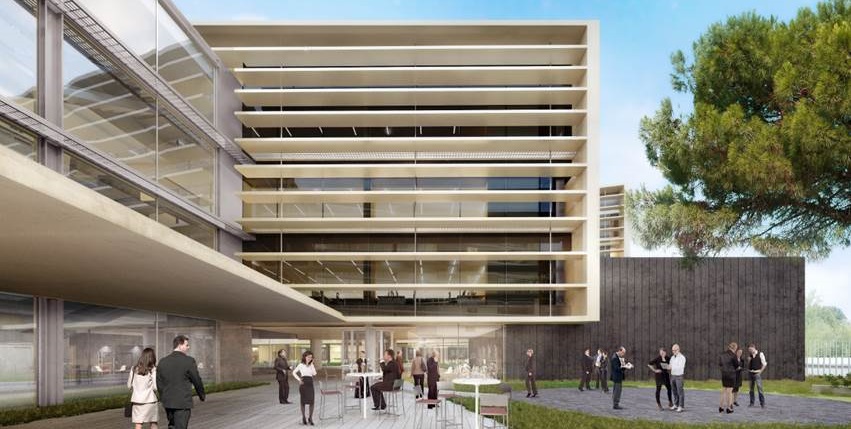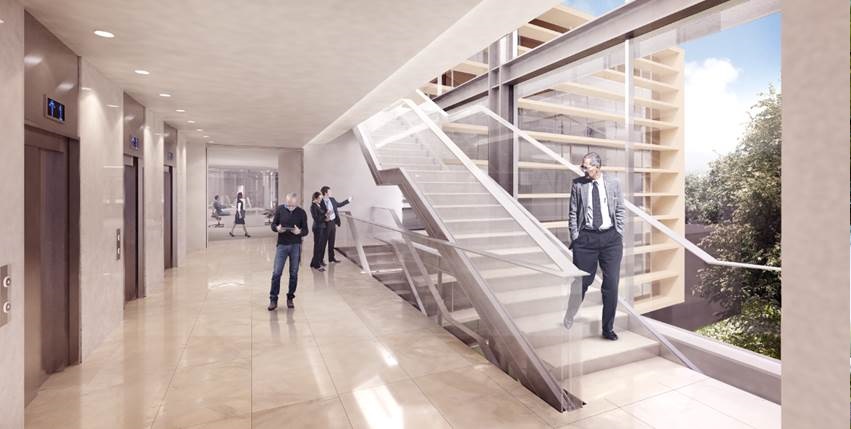EUIPO building - case study
In March 2017, EUIPO’s new building design was awarded the coveted Your BREEAM Award, at the BREEAM Awards ceremony in London. You can read Designing Buildings Wiki’s report about the ceremony here.
Designated the Eidificio EUIPO AA3, the building is currently under construction, and on completion will form part of the sustainable campus envisaged by EUIPO for its Alicante headquarters.
The EUIPO (European Union Intellectual Property Office) is a decentralised agency of the European Union, which manages the registration of the European Union trademark (EUTM) and the Registered Community Design (RCD).
The building obtained an ‘Exceptional’ ranking from BREEAM, the highest possible classification, which only 2% of all evaluated buildings achieve. It is in the process of obtaining the same classification for the post-construction phase.
The building is approximately 14,000 sq. m, and when compared with a traditionally constructed building of the same size, the design allows for a 71% reduction in CO2 emissions and a 67% reduction in energy.
The new AA3 Project benefits from the lessons learned during the BREEAM certification process of the AA2 building in 2015, and also from the 'In-Use' Certification of the AA1 building, which is currently in process.
Key features of the design include:
- Reduction in water consumption of 496.7 m3/year.
- Recycling or recovery of more than 95% of construction and demolition waste generated during the construction phase.
- Monitoring energy consumption with sub-meters in the main and secondary distribution boards, and by integrating them in the BMS system.
- Installation of energy-efficient equipment.
- Installation of lifts with an energy recovery system using a regenerative drive, that saves energy and feeds it back into the network with a positive charge.
- Monitoring water consumption via the BMS system.
- Re-use of greywater.
- Use of rainwater collected in storm tanks for watering plants.
- Implementation of low CO2 emissions technology.
- Maximum use of natural daylight.
- Use of cladding materials with low or ‘zero’ formaldehyde and VOC emissions.
- Use of environmentally-sustainable materials that have an Environmental Product Declaration (EPD).
- Use of recycled aggregates.
- Improvement of the biological quality of the site, with the creation of habitats with native plants that favour biodiversity.
- A strategy for eliminating existing invasive plants.
- The use of cooling gases with low CO2 emissions and installation of a leak-detecting system.
- Electricity supply obtained from renewable sources with zero emissions.
- A geothermal facility to cover heating and cooling needs.
- Installation of an adjustable outdoor lighting system to reduce night-time light pollution.
- Charging stations for electric vehicles, reserved car share parking spaces, and parking spaces for bicycles.
- Appointment of a commissioning manager.
- For the first three years of occupation, information will be compiled on occupant satisfaction, water and energy consumption, to check whether the building's performance meets the expected standards.
Project team:
- Client: European Union Intellectual Property Office (EUIPO)
- Architect: Carlos Rubio Carvajal, RUBIO Arquitectura
- BREEAM Assessor: Mercedes Cecilia García Ruiz, Servicios Ambientales Integrales del Norte, S.L.
- Contractor: FCC Construcción, S.A.
- Engineering: TYPSA
- Project Management Assistance: IDOM
- Site Supervision Team: GRUPOTEC
- Health and Safety Coordinator: PREMEA
- Quality control: TÜV ATISAE
Key facts:
- BREEAM Rating: Outstanding (Design Stage)
- Score: 90.85%
- Size: 13,993 m2
- BREEAM Version: BREEAM ES New Construction 2015
- Gross rentable area: 4,067.5 m2
- Plot surface : 14,032 m2
- Number of floors: Two below ground level and four above ground level
Images and content courtesy of EUIPO.
[edit] Find out more
[edit] Related articles on Designing Buildings Wiki
Featured articles and news
RTPI leader to become new CIOB Chief Executive Officer
Dr Victoria Hills MRTPI, FICE to take over after Caroline Gumble’s departure.
Social and affordable housing, a long term plan for delivery
The “Delivering a Decade of Renewal for Social and Affordable Housing” strategy sets out future path.
A change to adoptive architecture
Effects of global weather warming on architectural detailing, material choice and human interaction.
The proposed publicly owned and backed subsidiary of Homes England, to facilitate new homes.
How big is the problem and what can we do to mitigate the effects?
Overheating guidance and tools for building designers
A number of cool guides to help with the heat.
The UK's Modern Industrial Strategy: A 10 year plan
Previous consultation criticism, current key elements and general support with some persisting reservations.
Building Safety Regulator reforms
New roles, new staff and a new fast track service pave the way for a single construction regulator.
Architectural Technologist CPDs and Communications
CIAT CPD… and how you can do it!
Cooling centres and cool spaces
Managing extreme heat in cities by directing the public to places for heat stress relief and water sources.
Winter gardens: A brief history and warm variations
Extending the season with glass in different forms and terms.
Restoring Great Yarmouth's Winter Gardens
Transforming one of the least sustainable constructions imaginable.
Construction Skills Mission Board launch sector drive
Newly formed government and industry collaboration set strategy for recruiting an additional 100,000 construction workers a year.
New Architects Code comes into effect in September 2025
ARB Architects Code of Conduct and Practice available with ongoing consultation regarding guidance.
Welsh Skills Body (Medr) launches ambitious plan
The new skills body brings together funding and regulation of tertiary education and research for the devolved nation.
Paul Gandy FCIOB announced as next CIOB President
Former Tilbury Douglas CEO takes helm.
UK Infrastructure: A 10 Year Strategy. In brief with reactions
With the National Infrastructure and Service Transformation Authority (NISTA).
























